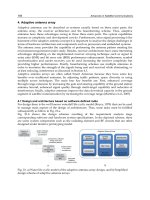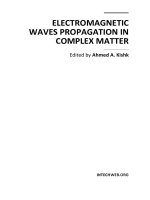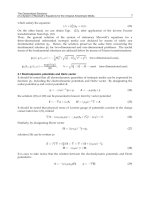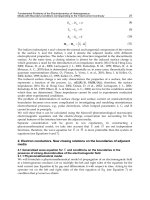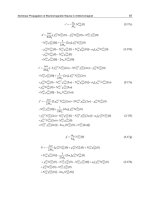Electromagnetic Waves Propagation in Complex Matter Part 14 docx
Bạn đang xem bản rút gọn của tài liệu. Xem và tải ngay bản đầy đủ của tài liệu tại đây (970.31 KB, 20 trang )
Electrodynamics of Multiconductor Transmission-line Theory with Antenna Mode 15
We can write the integrated change rate in a compact form.
P
antenna
t
=
l
0
dP
antenna
(x)
dx
dx
= −
1
2
M
|I
I
(l)|
2
+
1
2
Mc
2
|Q
I
(l)|
2
(63)
It is clear that the total change rate due to the antenna mode consists of the emission and
absorption terms, which are indicated by the minus sign term and the plus sign term.
We would like to comment here which process as emission or absorption occurs. When a
power supply is connected at the middle of one-conductor transmission-line, this antenna
operates for radiation-emission as a transmitter because the emission term is larger than
the absorption term. When a passive lumped circuit element is connected at the middle of
one-conductor transmission line, this antenna operates for radiation-absorption as a receiver
because the absorption term is larger than the emission term.
5. Three-conductor transmission-line system
We consider now the three-conductor transmission-line theory with emission and absorption
through the antenna mode. This is a very interesting case where the two-conductor
transmission-lines include the effect of the circumstance. In our previous publication (Toki
& Sato (2009)), we have discussed the case where the total current is zero and hence the case
without the antenna mode. The present situation with the antenna mode corresponds to the
realistic case. In this case we introduce the normal, common and antenna modes. They are
written with the currents and potentials of the three lines. Here, we consider that the lines 1
and 2 are the main lines and the line 3 denotes the circumstance.
I
n
=
1
2
(I
1
− I
2
) (64)
I
c
=
1
2
(I
1
+ I
2
− I
3
)
I
a
=
1
2
(I
1
+ I
2
+ I
3
)
V
n
= V
1
−V
2
V
c
=
1
2
(V
1
+ V
2
) −V
3
V
a
=
1
2
(V
1
+ V
2
)+V
3
We work out the coupled integro-differential equations for the TEM mode with the retardation
term treated explicitly. There is a factor two difference between the antenna mode current and
the total current I
t
= 2I
a
. We write the results here for the normal, common and antenna
modes. We use first the integro-differential equations for N
= 3 in Eq. (37) and express the
equations in terms of various modes,
∂V
n
(x, t)
∂x
= −L
n
∂I
n
(x, t)
∂t
− L
nc
∂I
c
(x, t)
∂t
− L
na
∂I
a
(x, t)
∂t
− R
n
I
n
− R
nc
I
c
− R
na
I
a
(65)
∂V
c
(x, t)
∂x
= −L
cn
∂I
n
(x, t)
∂t
− L
c
∂I
c
(x, t)
∂t
− L
ca
∂I
a
(x, t)
∂t
− R
cn
I
n
− R
c
I
c
− R
ca
I
a
∂V
a
(x, t)
∂x
= −L
an
∂I
n
(x, t)
∂t
− L
ac
∂I
c
(x, t)
∂t
− L
a
∂I
a
(x, t)
∂t
− j2M
m
∂I
I
t
(l, x, t)
∂t
−R
an
I
n
− R
ac
I
c
− R
a
I
a
247
Electrodynamics of Multiconductor Transmission-line Theory with Antenna Mode
16 Will-be-set-by-IN-TECH
In the above equations all the coefficients are written as follows,
L
n
= L
11
−2L
21
+ L
22
(66)
L
c
=
1
4
(L
11
+ 2L
12
+ L
22
) −(L
13
+ L
23
)+L
33
L
a
=
1
4
(L
11
+ 2L
12
+ L
22
)+L
13
+ L
23
+ L
33
,
for the diagonal coefficients and
L
nc
=
1
2
(L
11
− L
22
) −(L
13
− L
23
) (67)
L
na
=
1
2
(L
11
− L
22
)+(L
13
− L
23
)
L
ca
=
1
4
(L
11
+ 2L
12
+ L
22
) − L
33
,
for the non-diagonal coefficients. We get the resistance terms as
R
n
= R
1
+ R
2
(68)
R
c
=
1
4
(R
1
+ R
2
)+R
3
R
a
=
1
4
(R
1
+ R
2
)+R
3
R
nc
=
1
2
(R
1
− R
2
)
R
na
=
1
2
(R
1
− R
2
)
R
ca
=
1
4
(R
1
+ R
2
) − R
3
We obtain similar relations for transmission-line equations (36) including P
ij
as written below.
∂V
n
(x, t)
∂t
= −P
n
∂I
n
(x, t)
∂x
− P
nc
∂I
c
(x, t)
∂x
− P
na
∂I
a
(x, t)
∂x
(69)
∂V
c
(x, t)
∂t
= −P
cn
∂I
n
(x, t)
∂x
− P
c
∂I
c
(x, t)
∂x
− P
ca
∂I
a
(x, t)
∂x
∂V
a
(x, t)
∂t
= −P
an
∂I
n
(x, t)
∂x
− P
ac
∂I
c
(x, t)
∂x
− P
a
∂I
a
(x, t)
∂x
+ j2M
e
∂Q
I
t
(l, x, t)
∂t
In the above equations all the coefficients are written as follows,
P
n
= P
11
−2P
12
+ P
22
(70)
P
c
=
1
4
(P
11
+ 2P
12
+ P
22
) −(P
13
+ P
23
)+P
33
P
a
=
1
4
(P
11
+ 2P
12
+ P
22
)+P
13
+ P
23
+ P
33
,
248
Electromagnetic Waves Propagation in Complex Matter
Electrodynamics of Multiconductor Transmission-line Theory with Antenna Mode 17
for the diagonal coefficients and
P
nc
=
1
2
(P
11
− P
22
) −(P
13
− P
23
) (71)
P
na
=
1
2
(P
11
− P
22
)+(P
13
− P
23
)
P
ca
=
1
4
(P
11
+ 2P
12
+ P
22
) − P
33
,
for the non-diagonal coefficients. All the coefficients of potential P
ij
are written in a compact
form as the coefficients of inductance L
ij
.
L
ij
=
μ
2π
(ln
2
˜
l
˜
a
ij
−1) (72)
P
ij
=
1
2πε
(ln
2
˜
l
˜
a
ij
−1)
Using these coefficients, we can write all the coefficients associated with the normal, common
and antenna modes. They are written as
P
n
=
1
2πε
ln
˜
a
2
12
˜
a
11
˜
a
22
(73)
P
c
=
1
8πε
ln
˜
a
4
13
˜
a
4
23
˜
a
11
˜
a
22
˜
a
2
12
˜
a
4
33
P
a
=
1
8πε
(ln
(2
˜
l)
16
˜
a
11
˜
a
22
˜
a
2
12
˜
a
4
33
˜
a
4
13
˜
a
4
23
−16)
Only the antenna mode coefficient P
a
contains the length of the transmission-lines explicitly
and is appropriate for the antenna mode. The coupling terms are written as
P
nc
=
1
2πε
ln
˜
a
22
a
13
˜
a
11
˜
a
23
(74)
P
na
=
1
2πε
ln
˜
a
22
a
23
˜
a
11
˜
a
13
P
ca
=
1
8πε
ln
˜
a
4
33
˜
a
11
˜
a
22
˜
a
2
12
We get similar expressions for L
i
. They are related with P
i
as L
i
= P
i
c
2
. It is very interesting
to note that the coefficient of capacity for the normal mode is written as C
n
= 1/P
n
=
2πε/ln
˜
a
2
12
˜
a
11
˜
a
22
.
The coupled differential equations tell many interesting facts. When there is a symmetry
between the lines 1 and 2 in their relations to the third line due to the symmetric arrangement,
the coupling terms of the normal mode to both the common and antenna modes can be made
zero. The normal mode decouples from the common and antenna modes. On the other hand,
when the symmetry is lost between the lines 1 and 2, the normal mode couples not only
with the common mode but also with the antenna mode. This coupling of three wave-type
modes is considered to be the origin of EM noise, which can not be understood due to the
249
Electrodynamics of Multiconductor Transmission-line Theory with Antenna Mode
18 Will-be-set-by-IN-TECH
reflection and interference. It is therefore very important to take care of the symmetry of the
lines 1 and 2. We repeat that if the third line represents the circumstance, it is impossible to
make the coupling terms zero. Hence, the ordinary two-conductor transmission-line system is
influenced by the circumstance and the electromagnetic emission and absorption take place.
Therefore, we cannot avoid the noise problem. In addition, we comment that the common
mode always couples with the antenna mode and the emission and absorption take place
simultaneously with the generation of the EM noise in the circuit.
It is interesting to write the differential equation for the normal mode for the case of
symmetrization, where the coupling terms of the normal mode to the common and antenna
modes are zero. The TEM mode differential equations for the normal mode are written as
∂V
n
(x, t)
∂t
= −P
n
∂I
n
(x, t)
∂x
(75)
∂V
n
(x, t)
∂x
= −L
n
∂I
n
(x, t)
∂t
− R
n
I
n
.
These differential equations for the normal mode together with the coefficients L
n
, P
n
and R
n
agree with the two-conductor transmission-line equations (Paul (2008)). Usually the upper
equation in Eq. (75) is written in terms of 1/C
n
in the place of P
n
. The expression for C
n
calculated by C
n
= 1/P
n
= 2πε/ln
˜
a
2
12
˜
a
11
˜
a
22
agrees with the capacitance per unit length of the
usual two line expression. We stress again the use of the coefficient of potential is essential
for the formulation of the three-line system. Hence, the ordinary TEM mode propagation of
the EM wave is achieved only when the symmetrization is introduced for the electric circuit
in the circumstance.
We shall calculate the electromagnetic power of the three-conductor transmission-line system.
P
(x)=
1
4
(V
∗
1
I
1
+ V
∗
2
I
2
+ V
∗
3
I
3
+ V
1
I
∗
1
+ V
2
I
∗
2
+ V
3
I
∗
3
) (76)
=
1
4
(V
∗
n
I
n
+ V
∗
c
I
c
+ V
∗
a
I
a
+ V
n
I
∗
n
+ V
c
I
∗
c
+ V
a
I
∗
a
)
It is interesting to calculate the change of the power with distance so that we can pick up
only the terms which change with distance. We take the time dependence of all the modes
as exp
(−jωt). We can work out the change rate
dP(x)
dx
on the basis of Eqs. (65) and (69) in
exactly the same way as the case of the one-conductor transmission line. We write only the
final result.
dP(x)
dx
= −
1
2
(R
n
|I
n
(x)|
2
+ R
c
|I
c
(x)|
2
+ R
a
|I
a
(x)|
2
(77)
+R
nc
(I
n
(x)I
∗
c
(x)+I
∗
n
(x)I
c
(x)) + R
na
(I
n
(x)I
∗
a
(x)
+
I
∗
n
(x)I
a
(x)) + R
ca
(I
c
(x)I
∗
a
(x)+I
∗
c
(x)I
a
(x)))
−
1
2
Mω
c
(I
I∗
t
(l, x)I
a
(x)+I
I,x
t
(l)I
∗
a
(x))
−
j
1
2
Mc
Q
I∗
t
(l, x)
dI
a
(x)
dx
− Q
I
t
(l.x)
dI
∗
a
(x)
dx
This expression agrees with the one of the line-antenna (62), when the change rate is expressed
with the total current by using the relation I
a
(x)=
1
2
I
t
(x). It is interesting to point out that
the change of the electric power is made by the resistance terms and the antenna mode terms.
250
Electromagnetic Waves Propagation in Complex Matter
Electrodynamics of Multiconductor Transmission-line Theory with Antenna Mode 19
There are two effects in the antenna mode terms. One is a term associated with emission and
the other is a term associated with absorption.
Here, we would like to comment the strict symmetrization of the power supply. In a standard
two-stage power supply in which two identical power supplies are connected in series but
switchings are controlled alternately, a common mode current is unavoidable. Even when
there is a symmetry between lines 1 and 2 in relation to the third line, coupling terms
between the common and antenna modes do not vanish unavoidably. This implies that
the radiation of EM wave occurs unless the common mode current is eliminated. The most
effective method of eliminating the common and antenna modes is a strict symmetrization
in which switchings of two-stage power supply should be synchronized in a symmetrized
three-conductor transmission-line system.
6. Symmetrized electric circuit
In the previous section, we have discussed the performance of two transmission-lines in the
circumstance and hence a three-conductor transmission-line system. The electromagnetic
noise in the circumstance goes through the third line in the form of electromagnetic wave.
In the standard two-stage power supply as mentioned above, the noise in the circumstance
influences the main two-lines through the common mode. Since we are not able to control the
circumstance, it is impossible to remove the electromagnetic noise in the case of the two line
electric circuit in the circumstance. At the same time, the modern power supply and also both
the inverter and converter use the chopping method and generate electromagnetic noise with
high frequency. This noise goes through the standard two line circuit and at the same time
goes out from the circuit in the form of electromagnetic wave.
The way out is to introduce a new third line to the main two line system in order to minimize
the effect of the circumstance by asking the new third line to take care of the common mode
effect. We are then able to control the whole electric circuit by arranging all the elements
(conductor-lines, powers, loads etc.) so as to minimize the effect of noise. One very important
thing is to introduce two identical power supplies and connect the third line to the middle
point of the two power supplies. In this way, the common mode noise produced in the power
supply system finds a way to go through the third line and does not go out from the electric
circuit.
It is then important to decouple the normal mode from the common mode. This is achieved
by using the same size and same quality transmission-lines for the main two lines and by
arranging the geometrical distances of the two lines to the third line equal. At the same time,
we have to arrange lumped-loads symmetrically around the third line. We have discussed
why the normal mode decouples from the common mode in a symmetrical arrangement
by calculating three-line lumped-circuit in our first publication (Sato & Toki (2007)), which
reviewed the design principle of HIMAC synchrotron (Kumada (1994)) and provided a guide
of alteration of magnet wiring of J-PARC MR (Kobayashi (2009)). The present new MTL theory
with the antenna mode tells that the conditions of the normal mode to decouple from the
common and antenna modes are to impose the symmetrization among the three-conductor
transmission-lines in addition to the symmetrization of the lumped elements.
We show one example of electric circuit to use the normal mode current with largely reduced
noise by the symmetric arrangement around the third line as shown in Fig.1. The present day
power supply uses a chopping device and produces high frequency noise. We use a standard
two-stage power supply and connect the third line at the middle point of the two-stage power
supply denoted by P to confine high frequency noise produced by the power supply. The
filtering device F should cut down high frequency noise and allows only low frequency noise
to pass through the filter. It should be noted that the filtering device F consists of the common
251
Electrodynamics of Multiconductor Transmission-line Theory with Antenna Mode
20 Will-be-set-by-IN-TECH
PF
L
L
ij
P
ij
R
i
M
Fig. 1. A symmetrized electric circuit for the use of the normal mode decoupled from the common and
antenna modes. Around the third line (middle line) two power supplies P, the filtering element F are
placed in the left end and the electric loads L are placed in the right end. The connecting three-conductor
transmission lines have the properties of self and mutual inductances L
ij
denoted by coil, self and
mutual coefficients of potential P
ij
denoted by short parallel lines, resistance R
i
and antenna mode
coefficient M. The three-conductor transmission lines are coupled each other and their performance
follows a coupled integro-differential equation with these coefficients.
mode filter in addition to the normal mode filter in order to cut down not only the normal
mode noise but also the common mode noise. In the right end of the three-lines placed are
electric loads L symmetrically. The arrangement of these lumped devices symmetrically is the
requirement of the decoupling of the normal mode from the common mode.
Very important fact is now that these power-filter element P
− F and the electric loads L are
connected by transmission-lines, which are not just structureless lines, but contain several
functions as inductance L
ij
, coefficient of potential P
ij
, resistance R
i
and antenna coefficient
M. There are self- and mutual-inductances L
ij
and they are denoted by coils on lines and
connections of coils as usual in Fig.1. We denote the coefficients of potential P
ij
, which have
both self- and mutual-coefficients, by two short parallel lines and connections of short parallel
lines. We abandon here the concept of capacitor C
ij
and use a similar but rotated symbol for
P
ij
. The resistances R
i
are denoted by the standard symbol and are attached to each line. In
addition, we have the antenna coefficient M for radiation, which is associated with the whole
transmission-lines and use the connection symbol with two arrows indicating radiation. The
performance of the transmission-lines iscontrolled then by a set of coupled integro-differential
equations with these coefficients L
ij
, P
ij
, R
i
and M. At a glance of Fig.1, readers might picture
that the symmetric arrangement provides decoupling of normal mode from common and
antenna modes because of L
nc
= L
na
= 0 in Eq. (67), R
nc
= R
na
= 0 in Eq. (68) and
P
nc
= P
na
= 0 in Eq. (71). Consequently, the symmetric arrangement of the transmission-lines
and the lumped elements are the necessary step for the good performance of an electric circuit.
We should on top consider that the noise is EM wave and goes through the transmission-lines
in the TEM mode with loss of Joule and radiation energies.
7. Conclusion
We have constructed a new multi-conductor transmission-line (MTL) theory with the antenna
mode. To this end, we have started from the electrodynamics field theory, which denotes
that sources of electric and magnetic fields outside the conductors are true charge and
conduction current inside the conductors. Based on the definite statement of the field theory,
it is allowed to consider the dynamics of charge and current in resistive conductors of
252
Electromagnetic Waves Propagation in Complex Matter
Electrodynamics of Multiconductor Transmission-line Theory with Antenna Mode 21
transmission-lines of thick wires and their coupling to the electromagnetic fields surrounding
the transmission-lines. We have used the continuity equation of the charge and current
and the combined equation of the boundary condition at the surface and the Ohm’s law
with the resistance, which controls the movement of the charge and current. The Maxwell
equation then relates the dynamics of the charge and current to the scalar and vector potentials
surrounding the transmission-lines. Since we are interested in the performance of the
electromagnetic fields outside of the MTL system, we solve the wave equations for the scalar
and vector potentials in the Lorenz gauge with the retardation charge and current. The scalar
and vector potentials are now expressed in the integral forms and they are called retarded
potentials. These four equations are the fundamental equations for the MTL system with the
antenna mode. The coupled integro-differential equations are to be solved for the propagation
of the electromagnetic wave and the energy loss due to the Joule and radiation processes.
To proceed, we have analyzed the retardation potentials for each frequency mode. The
retardation charge and current introduces the real part with a cosine function and the
imaginary part with a sine function. We are then able to make the TEM mode approximation
for the real part, but should keep the imaginary part in the integral form. This TEM
mode approximation can relate the scalar and vector potentials at the surface of each
transmission-line with the charge and current for the introduction of the coefficients of
potential P
ij
and inductance L
ij
. In this process, we consider the retardation charge and
current effect explicitly. Hence, we modify the coefficients of inductance L
ij
and potential
P
ij
by including the ω dependent term cos(ω
(x − x
)
2
+ d
2
ij
/c) in the integrand. As for the
imaginary terms, we have now the omega dependent term sin
(ω|x − x
|/c) in the numerator
and should keep the integral form. We call the newly added integral terms coming from the
imaginary parts of the retardation charge and current as the antenna mode terms with antenna
mode coefficients M
e
and M
m
. We are then able to express MTL integro-differential equations
for the scalar potential and the current by eliminating the charge and the vector potentials
by using the continuity equation which is equivalent to the current conservation equation of
the field theory and the combined equation of the boundary condition and the Ohm’s law
equation.
We have worked out an one-conductor transmission-line system to discuss the standard
line-antenna with the propagation of a TEM mode through the transmission-line. In this case,
we use the long wavelength approximation for the antenna mode terms originating from the
retardation terms. Due to the fact that we are able to calculate the coefficients of inductance
and potential, we can write down coupled integro-differential equations for potential V and
current I with L, P and M
e
, M
m
and R. We solve the coupled equations formally and work
out the input impedance, which is now a function of the size, the length and the resistance of
the transmission-line. We have explicitly worked out the case for one linear transmission-line
antenna. We can provide the solution of the differential equation and give an expression of
the input impedance Z
s
for the first time with the long wave length approximation after the
MTL equations are fixed for the TEM mode. We work out the power of the system at the
origin, which is eventually consumed by the Joule energy and the radiation energy. We have
provided the input impedance for a typical case of a line antenna of thick wire with resistance.
We have studied also a three-conductor transmission-line system with emission and
absorption. In addition to mathematical expressions, we propose a new circuit diagram of
multi-conductors on the basis of coefficient of potential, coefficient of inductance, coefficient
of antenna mode, and resistance. There appear three kinds of waves of normal, common,
and antenna modes. All these modes propagate around the transmission-lines in the TEM
mode waves. It is very interesting to point out if there is a symmetry between the lines 1 and
2 due to a symmetric arrangement, then the normal mode decouples from the common and
253
Electrodynamics of Multiconductor Transmission-line Theory with Antenna Mode
22 Will-be-set-by-IN-TECH
antenna modes simultaneously. On the other hand, when the symmetry between the lines 1
and 2 is lost, the normal mode couples with both the common and antenna modes. This is a
realistic situation of the ordinary two-conductor transmission-line system with the inclusion
of the circumstance. We have to introduce the third line to the main two line system, instead of
circumstance of which electrical performance is unclear, and symmetrize the system in order
to confine the electromagnetic fields within the three-line system with the help of the common
mode filter. In the near future we shall work out the skin effect by taking into account the
motion of the current to the radial direction of each transmission-line in the MTL theory with
the antenna mode (Sato & Toki (2011)).
Finally we would like to comment on a distinction between the present MTL theory
and the former standard two-conductor transmission-line theory from the view point of
electromagnetism. We consider resistive conductors for transmission-lines and abandon
the concept of perfect conductor. The TEM mode wave could exist even in the case of
one-conductor transmission line so that the TEM mode approximation is useful in the
present study. The coefficients of potential are important to determine not only the coupling
impedance between mutual transmission lines but also the characteristic impedance of a
single transmission line itself. Consequently, it is unnecessary for a transmission line theory
to introduce capacitance per unit length between two transmission lines and the displacement
current flowing through the capacitance for a transmission-line theory any more. The
boundary conditions for the electromagnetic fields at the surface of the resistive conductor
provide the propagation of the TEM mode and replaces the concept of the Kirchhoff’s current
law between two lines due to displacement current.
8. Acknowledgment
The authors are grateful to Prof. H. Kobayashi and Prof. H. Horiuchi for fruitful discussions
and encouragements.
9. References
Toki, H. and Sato, K., Journ. Phys. Soc. Jap. 78 No.9 (2009) 094201.
Paul, C.R., ’Analysis of Multiconductor Transmission Lines’, (Wiley-Internscience (IEEE),
New Jersey, 2008) 1.
Sato, K. and Toki, H., Nucl. Instr. Meth. (NIM) A565 (2007) 351.
Toki, H. and Sato, K., to be published in Journ. Phys. Soc. Jap. (2011).
Kumada, M. et al., Proc. 4th Euro. Part. Acc. Conf. (EPAC) (1994) 2338.
Kobayashi, H., Proc. of Particle Accelerator Conf. (2009) PAC09-WE1GRI02.
Takeyama, S., "Phenomenological Electromagnetic Theory" (Japanese), Maruzen pub. (1983)
1.
Maxwell, J. C., A Treatise on Electricity & Magnetism (Dover Publication Inc., New York, 1876)
Vols. 1 and 2.
Bjorken, J.D. and Drell, S.D., ’Relativistic quantum mechanics’ McGraw Hill (New-York)
(1970) 1.
Lorenz, L., Dansk. Vid. Selsk. Forch. (1867) 26.
Rieman, B., Ann. Phys. 131 (1867) 237.
Jackson,J.D., ’Classical Electrodynamics’, 3rd ed. (John Wiley & Sons, 1998).
Sato, K. and Toki, H., to be published (2011).
Kirchhoff, G., Ann. Phys. 100 (1857) 193.
Ohta, K. (2005). Vortex of Maxwell and Watch of Einstein in Japanese, Tokyo University Press.
Stratton, J.A., ’Electromagnetic Theory’, McGraw-Hill Book Company, New York and London
(1941).
254
Electromagnetic Waves Propagation in Complex Matter
10
Propagation in Lossy Rectangular Waveguides
Kim Ho Yeap
1
, Choy Yoong Tham
2
,
Ghassan Yassin
3
and Kee Choon Yeong
1
1
Tunku Abdul Rahman University
2
Wawasan Open University
3
University of Oxford
1,2
Malaysia
3
United Kingdom
1. Introduction
)In millimeter and submillimeter radio astronomy, waveguide heterodyne receivers are
often used in signal mixing. Wave guiding structures such as circular and rectangular
waveguides are widely used in such receiver systems to direct and couple extraterrestrial
signals at millimeter and submillimeter wavelengths to a mixer circuit (Carter et al., 2004;
Boifot et al., 1990; Withington et al., 2003).
To illustrate in detail the applications of waveguides in receiver systems, a functional block
diagram of a typical heterodyne receiver in radio telescopes is shown in Fig. 1
(Chattopadhyay et al., 2002). The electromagnetic signal (RF signal) from the antenna is
directed down to the front end of the receiver system via mirrors and beam waveguides
(Paine et al., 1994). At the front end of the receiver system, such as the sideband separating
receiver designed for the ALMA band 7 cartridge (Vassilev and Belitsky, 2001a; Vassilev
and Belitsky, 2001b; Vassilev et al., 2004), the RF signal is channelled from the aperture of
the horn through a circular and subsequently a rectangular waveguide, before being
coupled to the mixer. In the mixer circuit, a local oscillator (LO) signal which is generally of
lower frequency is then mixed with the RF signal, to down convert the RF signal to a lower
intermediate frequency (IF) signal. Here, a superconductor-insulator-superconductor (SIS)
heterodyne mixer is commonly implemented for the process of down conversion. At the
back end of the system, the IF signal goes through multiple stages of amplification and is,
eventually, fed to a data analysis system such as an acousto-optic spectrometer. The data
analysis system will then be able to perform Fourier transformation and record spectral
information about the input signal.
The front-end receiver noise temperature T
R
is determined by a number of factors. These
include the mixer noise temperature T
M
, the conversion loss C
Loss
, the noise temperature of
the first IF amplifier T
IF
, and the coupling efficiency between the IF port of the junction and
the input port of the first IF amplifier
IF
. A comparison of the performance of different SIS
waveguide receivers is listed in Table 1 (Walker et al., 1992). It can be seen that the value of
T
R
for the 230 GHz system is a factor of 3 to 4 less than that achieved with the 492 GHz
system. The decrease in system performance at 492 GHz is due to the increase of C
Loss
and
T
M
by a factor of approximately 3.
Electromagnetic Waves Propagation in Complex Matter
256
Fig. 1. Block diagram of a heterodyne receiver.
SIS Junction Nb Pb Nb
Center Frequency (GHz) 230 345 492
T
R
(K) 48 159 176
T
M
(K) 34 129 123
C
Loss
(dB) 3.1 8.1 8.9
T
IF
(K) 7.0 4.2 6.8
Table 1. Comparison of SIS receiver performance.
Since the input power level of the weak millimeter and submillimeter signals is quite small –
i.e. of the order of 10
–18
to 10
–20
W (Shankar, 1986), it is therefore of primary importance to
minimize the conversion loss C
Loss
of the mixer circuit. One way of doing so, is to ensure that
the energy of the LO and, in particular, the RF signals is channelled and coupled from the
waveguides to the mixer circuit in a highly efficient manner. It is simply too time consuming
and too expensive to develop wave guiding structures in a receiver system on a trial-and-
error basis. To minimize the loss of the propagating signals, the availability of an accurate
and easy-to-use mathematical model to compute the loss of such signals in wave guiding
structures is, of course, central to the development of receiver circuits.
2. Related work
Analysis of the propagation of wave in circular cylindrical waveguides has already been
widely performed (Glaser, 1969; Yassin et al., 2003; Claricoats, 1960a; Claricoats, 1960b; Chou
and Lee, 1988). The analyses by these authors are all based on the rigorous method formulated
by Stratton (1941). In Stratton’s formulation, the fields at the wall surface are made continuous
into the wall material. Assumption made on the field decaying inside the wall material yields
relations which allow the propagation constant to be determined. Due to the difficulty in
matching the boundary conditions in Cartesian coordinates, this approach, however fails to be
implemented in the case of rectangular waveguides. A similar rigorous technique to study the
attenuation of rectangular waveguides is not available hitherto.
The perturbation power-loss method has been commonly used in analyzing wave
attenuation in lossy (Stratton, 1941; Seida, 2003; Collin 1991; Cheng, 1989) and
superconducting (Winters and Rose, 1991; Ma, 1998; Wang et al., 1994; Yalamanchili et al.,
1995) rectangular waveguides; respectively. This is partly due to its ability to produce
simple analytical solution, and also partly because it gives reasonably accurate result at
frequencies f well above its cutoff frequency f
c
. In this method, the field expressions are
derived by assuming that the walls to be of infinite conductivity. This allows the solution to
Propagation in Lossy Rectangular Waveguides
257
be separated into pure Transverse Electric (TE) and Transverse Magnetic (TM) modes. For a
waveguide with finite conductivity, however, a superposition of both TE and TM modes is
necessary to satisfy the boundary conditions (Stratton, 1941; Yassin et al., 2003). This is
because, unlike those of the lossless case, the modes in a lossy waveguide are no longer
mutually orthogonal to each other (Collin, 1991). To calculate the attenuation, ohmic losses
are assumed due to small field penetration into the conductor surface. Results however
show that this method fails near cutoff, as the attenuation obtained diverges to infinity
when the signal frequency f approaches the cutoff f
c
. Clearly, it is more realistic to expect
losses to be high but finite rather than diverging to infinity. The inaccuracy in the power-
loss method at cutoff is due to the fact that the field equations are assumed to be identical to
those of a lossless waveguide. Since a lossless waveguide behaves exactly like an ideal high
pass filter, signals cease to propagate at f below f
c
.
It can be seen that the assumption of lossless fields fail to give an insight or deeper
understanding on the mechanism of the propagation of wave in practical lossy waveguides.
Moreover, at very high frequency – especially that approaches the millimeter and
submillimeter wavelengths – the loss tangent of the conducting wall decreases. Therefore,
such assumption turns out to be inaccurate at very high frequency. Although Stratton (1941)
has developed a truly fundamental approach to analyze waveguides, his approach is only
restricted to the case of circular waveguides and could not be applied to rectangular
waveguides. The workhorse of this chapter is, therefore, to develop a novel and accurate
formulation – i.e. one that does not assume lossless boundary conditions – to investigate the
loss of waves in rectangular waveguides. In particular, the new method shall be found more
accurate and useful for waveguides operating at very high frequencies, such as those in the
millimeter and submillimeter wavelengths. In Yeap et al. (2009), a simple method to
compute the loss of waves in rectangular waveguides has been developed. However, the
drawback of the method is that different sets of characteristic equation are required to solve
for the propagation constants of different modes. Here, the method proposed in Yeap et al.
(2009) shall be developed further so that the loss of different modes can be conveniently
computed using only a single set of equation. For convenience purpose, the new method
shall be referred to as the boundary-matching method in the subsequent sections.
Fig. 2. A waveguide with arbitrary geometry.
Electromagnetic Waves Propagation in Complex Matter
258
3. General wave behaviours along uniform guiding structures
As depicted in Fig. 2, a time harmonic field propagating in the z direction of a uniform
guiding structure with arbitrary geometry can be expressed as a combination of elementary
waves having a general functional form (Cheng, 1989)
0
,exp[
j
()]
z
xy t kz
(1)
where ψ
0
(x, y) is a two dimensional vector phasor that depends only on the cross-sectional
coordinates, ω = 2πf the angular frequency, and k
z
is the propagation constant.
Hence, in using phasor representation in equations relating field quantities, the partial
derivatives with respect to t and z may be replaced by products with jω and jk
z
,
respectively; the common factor exp[j(ωt + k
z
z)] can be dropped. Here, the propagation
constant k
z
is a complex variable, which consists of a phase constant β
z
and an attenuation
constant α
z
j
zz z
k
(2)
The field intensities in a charge-free dielectric region (such as free-space), satisfy the
following homogeneous vector Helmholtz’s equation
222
()0
zzz
kk
) (3)
where ψ
z
is the longitudinal component of ψ,
2
is the Laplacian operator for the transverse
coordinates, and k is the wavenumber in the material. For waves propagating in a hollow
waveguide, k = k
0
, the wavenumber in free-space.
It is convenient to classify propagating waves into three types, in correspond to the
existence of the longitudinal electric field E
z
or longitudinal magnetic H
z
field:
1.
Transverse electromagnetic (TEM) waves. A TEM wave consists of neither electric fields
nor magnetic fields in the longitudinal direction.
2.
Transverse magnetic (TM) waves. A TM wave consists of a nonzero electric field but
zero magnetic field in the longitudinal direction.
3.
Transverse electric (TE) waves. A TE wave consists of a zero electric field but nonzero
magnetic field in the longitudinal direction.
Single-conductor waveguides, such as a hollow (or dielectric-filled) circular and rectangular
waveguide, cannot support TEM waves. This is because according to Ampere’s circuital
law, the line integral of a magnetic field around any closed loop in a transverse plane must
equal the sum of the longitudinal conduction and displacement currents through the loop.
However, since a single-conductor waveguide does not have an inner conductor and that
the longitudinal electric field is zero, there are no longitudinal conduction and displacement
current. Hence, transverse magnetic field of a TEM mode cannot propagate in the
waveguide (Cheng, 1989).
4. Fields in cartesian coordinates
For waves propagating in a rectangular waveguide, such as that shown in Fig. 3,
Helmholtz’s equation in (3) can be expanded in Cartesian coordinates to give
Propagation in Lossy Rectangular Waveguides
259
22
22
22
0
zz
zz
kk
xy
) (4)
By applying the method of separation of variables, ψ
z
can be expressed as
()()
z
XxYy
(5)
Equation (4) can thus be separated into two sets of second order differential equations, as
shown below (Cheng, 1989)
2
2
2
0
x
dX(x)
kX(x)
dx
(6)
2
2
2
0
y
dY(y)
kY(
y
)
dy
(7)
where k
x
and k
y
are the transverse wavenumbers in the x and y directions, respectively. The
longitudinal fields can be obtained by solving (6) and (7) based on a set of boundary
conditions and substituting the solutions into (5).
Fig. 3. The cross section of a rectangular waveguide.
The transverse field components can be derived by substituting the longitudinal field
components into Maxwell’s source free curl equations
-jEH
(8)
jHE
(9)
where ε and μ are the permittivity and permeability of the material, respectively. Expressing
the transverse field components in term of the longitudinal field components E
z
and H
z
, the
following equations can be obtained (Cheng, 1989)
Electromagnetic Waves Propagation in Complex Matter
260
22
zz
xz
xy
j
dH dE
H k ω
dx dy
kk
(10)
22
zz
yz
xy
j
dH dE
H k ω
dy dx
kk
(11)
22
zz
xz
xy
j
dE dH
E k ω
dx dy
kk
(12)
22
dx
dH
ω
dy
dE
k
kk
j
E
zz
z
yx
y
(13)
5. Review of the power-loss method
In the subsequent sections, analysis and comparison between the perturbation power-loss
method and the new boundary matching method shall be performed. Hence, in order to
present a complete scheme, the derivation of the conventional power-loss method is briefly
outlined in this section.
The attenuation of electromagnetic waves in waveguides can be caused by two factors – i.e.
the attenuation due to the lossy dielectric material α
z(d)
, and that due to the ohmic losses in
imperfectly conducting walls α
z(c)
(Cheng, 1989)
α
z
= α
z(d)
+ α
z(c)
, (14)
For a conducting waveguide, the inner core is usually filled with low-loss dielectric material,
such as air. Hence, α
z(d)
in (14) shall be assumed zero in the power-loss method and the loss
in a waveguide is assumed to be caused solely by the conduction loss. It could be seen later
that such assumption is not necessary in the new boundary-matching method. Indeed, the
new method inherently accounts for both kinds of losses in its formulation.
The approximate power-loss method assumes that the fields’ expression in a highly but
imperfectly conducting waveguide, to be the same as those of a lossless waveguide. Hence,
k
x
, k
y
, and k
z
are given as (Cheng, 1989)
x
m
k
a
(15)
y
n
k
b
(16)
zz
k
(17)
where
a and b are the width and height, respectively, of the rectangular waveguide; whereas
m and n denote the number of half cycle variations in the x and y directions, respectively.
Every combination of
m and n defines a possible mode for TE
mn
and TM
mn
waves.
Conduction loss is assumed to occur due to small fields’ penetration into the conductor
surfaces. According to the law of conservation of energy, the attenuation constant due to
conduction loss can be derived as (Cheng, 1989)
Propagation in Lossy Rectangular Waveguides
261
2
L
z
z
P
P
) (18)
where
P
z
is the time-average power flowing through the cross-section and P
L
the time-
average power lost per unit length of the waveguide.
Solving for
P
L
and P
z
based on Poynting’s theorem, the attenuation constant α
z
for TM and
TE modes – i.e.
α
z(TM)
and α
z(TE)
, respectively, can thus be expressed as (Collin, 1991)
23 23
()
2
22 22
2( )
1
s
zTM
c
Rmb na
f
ab m b n a
f
(19)
22
222
()
22
2
2
11
()()
1
cc
s
zTE
c
ff
R
bb mabna
af a f
mb na
f
b
f
(20)
where R
s
is the surface resistance, f
c
the cutoff frequency, and
the intrinsic impedance of
free space.
6. The new boundary-matching method
It is apparent that, in order to derive the approximate power-loss equations illustrated in
section 5, the field equations must be assumed to be lossless. In a lossless waveguide, the
boundary condition requires that the resultant tangential electric field E
t
and the normal
derivative of the tangential magnetic field
tn
Ha
to vanish at the waveguide wall, where
a
n
is the normal direction to the waveguide wall. In reality, however, this is not exactly the
case. The conductivity of a practical waveguide is finite. Hence, both E
t
and
tn
Ha
are not
exactly zero at the boundary of the waveguide. Besides, the loss tangent of a material
decreases in direct proportion with the increase of frequency. Hence, a highly conducting
wall at low frequency may exhibit the properties of a lossy dielectric at high frequency,
resulting in inaccuracy using the assumption at millimeter and submillimeter wavelengths.
In order to model the field expressions closer to those in a lossy waveguide and to account
for the presence of fields inside the walls, two phase parameters have been introduced in the
new method. The phase parameters – i.e
x
and
y
, are referred to as the field’s penetration
factors in the x and y directions, respectively. It is worthwhile noting that, with the
introduction of the penetration factors, E
t
and
tn
Ha
do not necessarily decay to zero at
the boundary, therefore allowing the effect of not being a perfect conductor at the
waveguide wall.
6.1 Fields in a lossy rectangular waveguide
For waves propagating in a lossy hollow rectangular waveguide, as shown in Figure 3, a
superposition of TM and TE waves is necessary to satisfy the boundary condition at the wall
(Stratton, 1941; Yassin et al., 2003). The longitudinal electric and magnetic field components
E
z
and H
z
, respectively, can be derived by solving Helmholtz’s homogeneous equation in
Electromagnetic Waves Propagation in Complex Matter
262
Cartesian coordinate. Using the method of separation of variables (Cheng, 1989), the
following set of field equations is obtained
0
sin sin
zxx
yy
EE kx ky
(21)
0
cos cos
zxx
yy
HH kx ky
(22)
where E
0
and H
0
are constant amplitudes of the fields.
The propagation constant k
z
for each mode will be found by solving for k
x
and k
y
and
substituting the results into the dispersion relation
222
0zx
y
kkkk (23)
Equations (21) and (22) must also apply to a perfectly conducting waveguide. In that case E
z
and
zn
Ha are either at their maximum magnitude or zero at both x = a/2 and y = b/2 –
i.e. the centre of the waveguide, therefore
sin sin 1 or 0
22
y
x
xy
kb
ka
(24)
Solving (24), the penetration factors are obtained as,
2
x
x
mka
(25)
2
y
y
nkb
(26)
For waveguides with perfectly conducting wall, k
x
= mπ/a and k
y
= nπ/b, (25) and (26) result
in zero penetration and E
z
and H
z
in (21) and (22) are reduced to the fields of a lossless
waveguide. To take the finite conductivity into account, k
x
and k
y
are allowed to take
complex values yielding non-zero penetration of the fields into the waveguide material
xx x
kj
(27)
yy y
k
j
(28)
where β
x
and β
y
are the phase constants and α
x
and α
y
are the attenuation constants in the x
and y directions, respectively. Substituting the transverse wavenumbers in (27) and (28) into
(23), the propagation constant of the waveguide k
z
results in a complex value, therefore,
yielding loss in wave propagation.
Substituting (21) and (22) into (10) to (13), the fields are obtained as
000
22
sin( )cos( )
zx y x x y y
x
xy
jkkH ω kE kx ky
H
kk
(29)
Propagation in Lossy Rectangular Waveguides
263
000
22
cos( )sin( )
zy x x x y y
y
xy
jkkH ω kE kx ky
H
kk
(30)
000
22
cos( )sin( )
zx y x x y y
x
xy
jkkE ω kH kx ky
E
kk
(31)
000
22
sin( )cos( )
zy x x x y y
y
xy
jkkE ω kH kx ky
E
kk
(32)
where μ
0
and ε
0
are the permeability and permittivity of free space, respectively.
6.2 Formulation
At the wall, the tangential fields must satisfy the relationship defined by the constitutive
properties μ
c
and ε
c
of the material. The ratio of the tangential component of the electric field
to the surface current density at the conductor surface is represented by (Yeap et al., 2009b;
Yeap et al., 2010)
tc
nt c
E
aH
(33)
where μ
c
and ε
c
are the permeability and permittivity of the wall material, respectively, and
c
c
is the intrinsic impedance of the wall material. The dielectric constant is complex and
ε
c
may be written as
0
c
c
j
(34)
where σ
c
is the conductivity of the wall.
In order to estimate the loss of waves in millimeter and submillimeter wavelengths more
accurately, a more evolved model than the conventional constant conductivity model used
at microwave frequencies is necessary. Here, Drude’s model is applied for the frequency
dependent conductivity σ
c
(Booker, 1982)
(1 )
c
j
(35)
where σ is the conventional constant conductivity of the wall material and τ the mean free
time. For most conductors, such as Copper, the mean free time τ is in the range of 10
–13
to
10
–14
s (Kittel, 1986).
At the width surface of the waveguide, y = b, E
z
/H
x
= −E
x
/H
z
=
c
c
. Substituting (21), (22),
(29), and (31) into (33), the following relationships are obtained
Electromagnetic Waves Propagation in Complex Matter
264
0
0
22
0
tan
xc
zx y y y
zc
xy
j
EE
kk k kb
HH
kk
(36a)
0
0
22
0
cot
xc
zx y y y
zc
xy
j
HH
kk k kb
EE
kk
(36b)
Similarly, at the height surface where x = a, we obtain E
y
/H
z
= −E
z
/H
y
=
c
c
. Substituting
(21), (22), (30), and (32) into (33), the following relationships are obtained
0
0
22
0
tan
y
c
zy x x x
zc
xy
E
j
E
kk k ka
HH
kk
(37a)
0
0
22
0
cot
y
c
zy x x x
zc
xy
H
j
H
kk k ka
EE
kk
(37b)
In order to obtain nontrivial solutions for (36) and (37), the determinant of the equations
must be zero (Yeap et al., 2009a). By letting the determinant of the coefficients of E
0
and H
0
in (36) and (37) vanish the following transcendental equations are obtained
2
00
22 22 22
tan cot
yyy yyy
cczx
cc
xy xy xy
j k kb j k kb
kk
kk kk kk
(38a)
2
00
22 22 22
tan cot
zy
xxx xxx
cc
cc
xy xy xy
kk
j k ka j k ka
kk kk kk
(38b)
Since the dominant TE
10
mode has the lowest cutoff frequency among all modes and is the
only possible mode propagating alone, it is of engineering importance. In the subsequent
sections, comparison and detail analysis of the TE
10
mode shall be performed. For the TE
10
mode, m and n are set to 1 and 0, respectively. Substituting m = 1 and n = 0 into the
penetration factors in (25) and (26), the transcendental equations in (38) for TE
10
mode can
be simplified to
2
00
22 22 22
tan cot
22
yy yy
zx
cc
cc
xy xy xy
bb
jk k jk k
jk k
kk kk kk
(39a)
2
00
22 22 22
cot tan
22
xx x x
zy
cc
c
c
xy xy xy
aa
jk k jk k
jk k
kk kk kk
(39b)
Propagation in Lossy Rectangular Waveguides
265
In the above equations, k
x
and k
y
are the unknowns and k
z
can then be obtained from the
dispersion relation in (23). A multi root searching algorithm, such as the Powell Hybrid root
searching algorithm in a NAG routine, can be used to find the roots of k
x
and k
y
. The routine
requires initial guesses of k
x
and k
y
for the search. For good conductors, suitable guess values
are clearly those close to the perfect conductor values i.e. β
x
= mπ/a, β
y
= nπ/b, α
x
= α
y
= 0.
Hence, for the TE
10
mode, the initial guesses for k
x
and k
y
are π/a and 0 respectively.)
6.3 Experimental setup
To validate the results, experimental measurements had been carried out. The loss as a
function of frequency for a rectangular waveguide was measured using a Vector Network
Analyzer (VNA). A 20 cm copper rectangular waveguide with dimensions of a = 1.30 cm
and b = 0.64 cm such as that shown in Fig. 4 were used in the measurement.
To minimize noise in the waveguide, a pair of chokes had also been designed and fabricated
as shown in Fig. 5. A detail design of the choke drawn using AutoCAD are shown in Fig.
6(a) and Fig. 6(b).
In order to allow the waveguide to be connected to the adapters which are of different sizes,
a pair of taper transitions had also been used as shown in Fig. 7. Fig. 8 depicts the complete
setup of the experiment where the rectangular waveguide was connected to the VNA via
tapers, chokes, coaxial cables, and adapters. Before measurement was carried out, the
coaxial cables and waveguide adapters were calibrated to eliminate noise from the two
devices. The loss in the waveguide was then observed from the S
21
or S
12
parameter of the
scattering matrix. The measurement was performed in the frequencies at the vicinity of
cutoff.
Fig. 4. Rectangular waveguides with width a = 1.30 cm and height b = 0.64 cm.
Fig. 5. A pair of chokes made of aluminum.
Electromagnetic Waves Propagation in Complex Matter
266
)
(a) (b)
Fig. 6. Parameters of the (a) cross section and (b) side view of the choke.
Fig. 7. Taper transitions.
Fig. 8. A 20 cm rectangular waveguide connected to the VNA, via tapers, chokes, adapters,
and coaxial cables.



